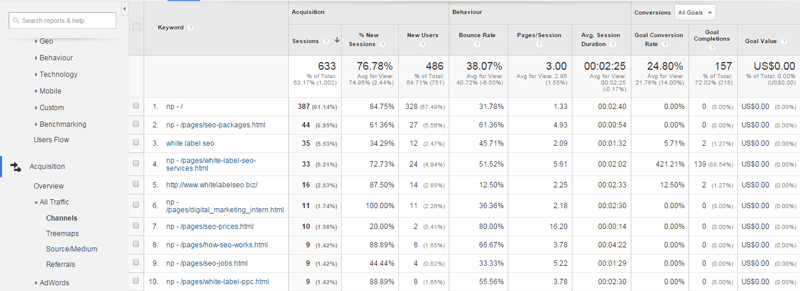On average, the ThoughtShift team increases eCommerce SEO revenue by 77% year on year, resulting in jumps in eCommerce SEO sales of anywhere from £100,000 – £1,000,000+ in the first 12 months.
We’re often asked, how we consistently deliver growth in organic eCommerce revenue and I’m sure you’ll be pleased to hear, it’s not a dark art – but, it is sprinkled with a bit of ThoughtShift magic.

Growing eCommerce SEO revenue starts with big data
Our proprietary ThoughtShift Buying Intent MethodologyTM turns the traditional approach to targeting generic keywords with high search volumes on it’s head by analysing the search behaviour of previous eCommerce buyers from your Google Analytics eCommerce tracking data.
So, if you haven’t yet enabled eCommerce Tracking for Google Analytics, do it now – there’s no additional cost from Google.
Although, development is usually required so you may be charged for a number of days work by your developer depending on how bespoke/old your site is.
If you use Magento you can add an extension or in Shopify, you can turn on eCommerce tracking as easily as ticking a check box.
Hurrah! Now you’ve got eCommerce data
Ideally the bigger the data the better, if you’ve got a year’s worth of Google Analytics data with eCommerce tracking enabled that’s ideal so you can see the seasonal trends over the last 12 months. If you’ve got 1 month’s worth of data, well that’s better than none at all and if you’re sitting smug with several years of data, then happy days indeed – you can look for longer term trends too!
Seek out the converting PPC keyword data
Mmmm this mouth-watering data source is the first place to start to see which keywords drive the most PPC revenue and therefore what you should consider targeting for your eCommerce SEO strategies. If you run pay per click campaigns, you can jump straight into the PPC Keywords Report:
Google Analytics > Acquisition > AdWords > Keywords (sort Conversions by highest eCommerce Revenue)
Sadly, if you don’t run any non-branded text ad based Google AdWords campaigns, you’ll have nil point on this rich revenue-driving data front.
But never fear, there’s plenty more insight here…
Rummage around for the converting SEO keyword data
Since Google went all “Not Provided” on our SEO Keyword Reports back in 2013, the large majority of SEO keywords are lumped in together and therefore don’t offer the same data.
However, if you have a high traffic site already, you will still find some converting SEO keyword insights from the SEO Keywords Report:
Google Analytics > Acquisition > All Traffic > Channels > Organic Search > Keywords (sort conversions by highest eCommerce Revenue)
Plus, if you’ve got a SEO friendly URL structure that says what it does on the tin and includes your category or product title in it clearly, you can add some nifty custom filters to pull the landing page in instead of the keyword into this same report.

It’s a little Google Analytics Not Provided data workaround that also helps you think about the eCommerce SEO approach to optimising pages and their hundreds of potential keyword variations rather than being limited to a few generic terms.
Deep dive into the SEO product sales insights
If you have neither the stomach nor the time for faffing about with custom filters, then the quickest way to get some juicy converting keywords is to find the products that drove the most sales from SEO by going to the Product Performance by SEO Report:
Google Analytics > Conversions > eCommerce > Product Performance (choose the Organic Traffic segment from the list and remove All Sessions)
Export the data into Excel to determine which keywords and product groups appear again and again. Once you find keywords appearing across multiple product sales categories or products that are driving the most eCommerce SEO revenue already, reverse engineer the keywords the product must be ranking in Google for, then Google it (or check your ranking tools).
If you’re not no. 1 already, then hey presto!
Prioritise this keyword for your eCommerce SEO strategy, prioritising keywords at position #2, then those at position #3 etc.
Many people aren’t aware that not only will a higher position of even 1 place, increase your visibility and traffic from that keyword, but if new customers see you first and like what they see, they are more likely to buy than trawling along down the list of less relevant possibilities! Therefore the eCommerce SEO conversion rate of a #1 ranking compared to a #2 ranking can be considerably higher, meaning you get more traffic AND it converts at an even higher rate – woo hoo!!
Bog yourself down in the best-sellers
If you don’t find you currently rank for many non-branded keywords or you do and are now hungry for more potential page 1 stunners, take a look at the best-selling products via other channels.
What are the best sellers via direct, referral, PPC and social media traffic?
Again, are there any product buying trends that can be grouped together under a family and translated into a set of similar keywords? The next step is to assess the current page 1 competition, by seeing who’s ranking there already and determining how quickly your site might be able to compete within the limitations of your resources.
Buying intent keyword gap gymnastics
Not content with the reams of proven converting keywords the previous data has revealed, the final stage of our search behavioural analysis is to cross reference our learnings with other audience insights to identify gaps.
This renegade stage, takes a running leap into the air of thinking what needs and problems trigger product purchases and unveils the kind of language your actual audience might use.

You can then assess these new exciting phrases using keyword research tools to see if they have regular search demand, often finding unexpected and surprising results.
Buying intent keyword example
The keyword “boho jewellery” gets 880 searches per month, compared to “boho wedding jewellery” which gets 20 searches per month.
The advantage being that fewer competitors are even considering targeting the longer tail keywords, so you can get on page 1 more quickly and they are more likely to have a high conversion rate due to the buying intent behind the phrase. We often see eCommerce SEO conversion rates of 10-100% for longer tail keywords.
In this particular example, if you’re selling a stunning piece of boho style jewellery that would make a bride-to-be’s day, the careful addition of this one crucial word into the product page copy of this higher priced item could result in driving very high value sales very quickly.
The result – you’ll be able to see your eCommerce SEO sales growing over time through increases in sales of the specific products/categories you’ve targeted.
In summary
Using keywords with buying intent found from your eCommerce Analytics big data is proven to increase eCommerce SEO revenue and could leave you with a cosy and highly measurable post-demographic data feeling.
Follow my contributions to the blog to find out more about eCommerce SEO or sign up to the ThoughtShift Guest List, our monthly email, to keep up-to-date on all our blogposts, guides and events.






